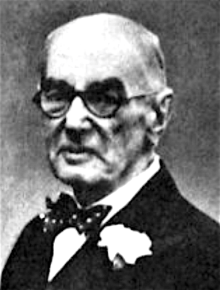
Ormrod Maxwell Ayrton [commonly known as Maxwell Ayrton] was born in Chester, Cheshire, England on 1 April 1874. He was articled to architect Harry Beswick of Chester, England (1890-94) and remained as his assistant (1894-97). He then worked as an assistant to William Alfred Pite (1860-1949) and to Edwin Landseer Lutyens (1897-99). During these years he also attended the South Kensington Schools in London.
In 1899 Ayrton opened his own independent office in London and in 1903 qualified as an architect. From 1905 onwards he was in partnership in London with John William Simpson (1858-1933) as Simpson & Ayrton. Most of Ayrton's most significant work was done with Simpson.
The Simpson & Ayrton partnership was dissolved in 1928 and Ayrton continued in independent practice. He was elected an Associate of the Royal Institute of British Architects (ARIBA) in 1903 and a Fellow of the Royal Institute of British Architects (FRIBA) in 1925. Between 1899-1939 he exhibited at the Royal Academy in London and at the Royal Scottish Academy in Edinburgh. He lived in London for much of his working life and died in Hampstead, Middlesex [now London] on 18 February 1960.
Projects by Ayrton and the Simpson & Ayrton partnership included extensions to Haileybury College in Hertfordshire and Lancing College in Sussex; the British Government Pavilion and other buildings at the British Empire Exhibition 1924-25 (including Wembley Stadium, originally known as the Empire Stadium); Tuke Buildings, Bedford College for Women in Regent's Park, London; new buildings for the National Institute for Medical Research in Mill Hill, London; The Tythings, premises for Messrs Kay in Worcester; new offices for the Presbyterian Church in Cheam and Bloomsbury, London; consulting architect for bridges at Twickenham, Lea Valley, Barking Creek, Wanford, Findhorn, Spey, etc.; and various domestic and farm buildings.
Ayrton also designed 'Mirror Grange', a massive dolls house for the 'Daily Mirror' newspaper, 'built' in 1927. The house was created as a 'home' for the newspaper's cartoon strip characters 'Pip, Squeak & Wilfred and toured Britain to raise money for charity.
______
For additional architectural work by Maxwell Ayrton see Historic England [link below]
Darley, Gillian. 'Relics of an empire: some of the surviving buildings of the British Empire Exhibition held in Wembley in 1924; Architects: Owen Williams & Maxwell Ayrton of Simpson & Ayrton.' Building Design no. 327, 10 December 1976 pp. 12-13.
'Derby stadium: projected municipal sports ground and social centre'. Building September 1948 pp. 264-270 [Architect: Maxwell Ayrton]
'Design co-ordination at Mill Hill: the National Institute for Medical Research'. Art & Industry February 1952 pp. 44-49 [Architect: Maxwell Ayrton]
Directory of British Architects 1834-1914. Compiled by Antonia Brodie, et al. Volume 1: A-K. London; New York: British Architectural Library, Royal Institute of British Architects/Continuum, 2001
Gray, A. Stuart. Edwardian architecture: a biographical dictionary. London: Gerald Duckworth & Co., Ltd., 1985
'Medical Research Council Library, National Institute for Medical Research, Mill Hill'. Aslib Proceedings May 1951 pp. 71-75 [Architect: Maxwell Ayrton]
'Medical Research Council Library, National Institute for Medical Research, Mill Hill'. Architect & Building News 12 May 1950 pp. 499-502 [Architect: Maxwell Ayrton]
'Medical Research Council Library, National Institute for Medical Research, Mill Hill'. Architects' Journal 11 May 1950 pp. 570-572 [Architect: Maxwell Ayrton]
'Medical Research Council Library, National Institute for Medical Research, Mill Hill'. The Builder 19 May 1950 pp. 673-677 [Architect: Maxwell Ayrton]
Mirror Grange.The book of the`Daily Mirror`s house for Pip,Squeak & Wilfred. Introduction by Alexander Campbell. London Daily Mirror Newspapers Ltd., 1929
‘Obituary’. The Builder vol. 198, 26 February 1960 p. 402
‘Obituary’. RIBA Journal vol. 67, May 1960 p. 247
'St. Andrew's Presbyterian church, Cheam Surrey'. Building September 1950 pp. 328-332 [Architect: Maxwell Ayrton]
'Wembley Stadium.' American Architect vol. 125, 7 May 1924 pp. 427-430 [Architects: J. W. Simpson & Maxwell Ayrton]
'Wembley Stadium'. British Builder January 1923 pp. 143-150 [Architects: J. W. Simpson & Maxwell Ayrton]
'Wembley Stadium'. The Builder 20 October 1922 pp. 569, 577, 581, 588, 589, 596. [Architects: J. W. Simpson & Maxwell Ayrton]